RESEARCH
Entry and exit screening of airline travellers during the A(H1N1) 2009 pandemic: a retrospective evaluation
Dépistage d'entrée et de sortie des passagers aériens au cours de la pandémie de grippe A(H1N1) en 2009: une évaluation rétrospective
Detección sistemática en las entradas y salidas de pasajeros de avión durante la pandemia de la gripe A (H1N1) en 2009: evaluación retrospectiva
Kamran KhanI,*; Rose EckhardtII; John S BrownsteinIII; Raza NaqviIV; Wei HuII; David KossowskyII; David ScalesV; Julien ArinoVI; Michael MacDonaldVII; Jun WangII; Jennifer SearsII; Martin S CetronVIII
IDepartment of Medicine, Division of Infectious Diseases, St Michael's Hospital, 30 Bond Street, Toronto, Ontario, M5B 1W8, Canada
IILi Ka Shing Knowledge Institute, St Michael's Hospital, Toronto, Canada
IIIChildren's Hospital Informatics Program, Boston Children's Hospital, Harvard Medical School, Boston, United States of America (USA)
IVDepartment of Medicine, University of Toronto, Toronto, Canada
VDivision of Emergency Medicine, Children's Hospital, Boston, USA
VIDepartment of Mathematics, University of Manitoba, Winnipeg, Canada
VIIDepartment of Geography, Ryerson University, Toronto, Canada
VIIIDivision of Global Migration and Quarantine, Centers for Disease Control and Prevention, Atlanta, USA
ABSTRACT
OBJECTIVE: To evaluate the screening measures that would have been required to assess all travellers at risk of transporting A(H1N1)pdm09 out of Mexico by air at the start of the 2009 pandemic.
METHODS: Data from flight itineraries for travellers who flew from Mexico were used to estimate the number of international airports where health screening measures would have been needed, and the number of travellers who would have had to be screened, to assess all air travellers who could have transported the H1N1 influenza virus out of Mexico during the initial stages of the 2009 A(H1N1) pandemic.
FINDINGS: Exit screening at 36 airports in Mexico, or entry screening of travellers arriving on direct flights from Mexico at 82 airports in 26 other countries, would have resulted in the assessment of all air travellers at risk of transporting A(H1N1)pdm09 out of Mexico at the start of the pandemic. Entry screening of 116 travellers arriving from Mexico by direct or connecting flights would have been necessary for every one traveller at risk of transporting A(H1N1)pdm09. Screening at just eight airports would have resulted in the assessment of 90% of all air travellers at risk of transporting A(H1N1)pdm09 out of Mexico in the early stages of the pandemic.
CONCLUSION: During the earliest stages of the A(H1N1) pandemic, most public health benefits potentially attainable through the screening of air travellers could have been achieved by screening travellers at only eight airports.
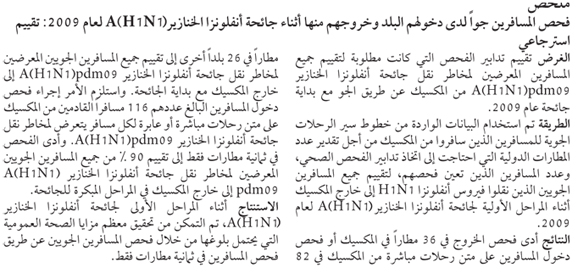

RÉSUMÉ
OBJECTIF: Évaluer les mesures de dépistage qui auraient été nécessaires pour dépister tous les voyageurs potentiellement porteurs du virus A(H1N1)pdm09 au départ du Mexique par avion au début de la pandémie de 2009.
MÉTHODES: Les données provenant des itinéraires de vol des voyageurs qui ont quitté le Mexique en avion ont été utilisées pour estimer le nombre d'aéroports internationaux où des mesures de dépistage médical auraient été nécessaires, et le nombre de voyageurs qui auraient dû être dépistés afin d'évaluer tous les voyageurs aériens qui pourraient avoir été porteurs du virus de la grippe H1N1 au départ du Mexique pendant les premiers stades de la pandémie A(H1N1) de 2009.
RÉSULTATS: Le dépistage de sortie dans 36 aéroports mexicains, ou le dépistage d'entrée des voyageurs arrivant sur des vols directs depuis le Mexique dans 82 aéroports de 26 autres pays, aurait permis d'évaluer tous les voyageurs aériens potentiellement porteurs du virus A(H1N1)pdm09 au départ du Mexique au début de la pandémie. Le dépistage d'entrée de 116 voyageurs arrivant du Mexique par des vols directs ou des correspondances aurait été nécessaire pour chacun des voyageurs aériens potentiellement porteurs du virus A(H1N1)pdm09. Le dépistage dans 8 aéroports seulement aurait permis d'évaluer 90% de tous les voyageurs aériens potentiellement porteurs du virus A(H1N1)pdm09 au départ du Mexique lors des premiers stades de la pandémie.
CONCLUSION: Au cours des premiers stades de la pandémie de grippe A(H1N1), la plupart des points bénéfiques pour la santé et potentiellement réalisables par le biais du dépistage des voyageurs aériens auraient pu être obtenus en dépistant les voyageurs dans seulement 8 aéroports.
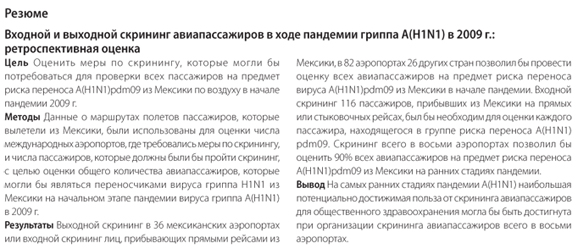
RESUMEN
OBJETIVO: Evaluar las medidas de detección sistemática que tendrían que haberse aplicado con el fin de analizar a todos los pasajeros de avión con riesgo de transportar el virus de la gripe A (H1N1) pdm09 desde México al principio de la pandemia de 2009.
MÉTODOS: Se analizaron los datos de los itinerarios de vuelo de los pasajeros que volaron desde México en esas fechas. A partir de dichos datos, se calculó el número de aeropuertos en los que habría sido necesario aplicar medidas de control sanitario y el número de pasajeros que se habría sometido a una detección sistemática. De este modo, se habría analizado a todos los que podrían haber transportado el virus de la gripe H1N1 desde México durante las fases iniciales de la pandemia de gripe A (H1N1) de 2009.
RESULTADOS: La detección sistemática a la salida de 36 aeropuertos mexicanos o a la entrada de los pasajeros de vuelos directos procedentes de México en 82 aeropuertos de 26 países podría haber dado como resultado la evaluación de todos los pasajeros de avión con riesgo de transportar el virus de la gripe A (H1N1)pdm09 desde México al principio de la pandemia. Para poder detectar a todos los pasajeros de avión con riesgo de transportar el virus de la gripe A (H1N1)pdm09 habría sido necesario aplicar la detección sistemática a la entrada de 116 pasajeros de los aviones procedentes de México (directos o con escala). De haber aplicado la detección sistemática en tan solo ocho aeropuertos se habría obtenido una evaluación del 90% de todos los pasajeros con riesgo de transportar el virus de la gripe A (H1N1) desde México en las primeras fases de la pandemia.
CONCLUSIÓN: Durante las primeras fases de la pandemia del virus de la gripe A (H1N1) podrían haberse alcanzado los mayores beneficios en cuanto a sanidad pública aplicando la detección sistemática de pasajeros en tan solo ocho aeropuertos.
Introduction
New infectious diseases appear to be emerging faster now than ever before, and many diseases that were once controlled are re-emerging.1 These trends are probably driven by the convergence of various global forces, including growth in the human population, urbanization, changes in the interactions between human and animal populations, climate change, and increases in international travel and trade.26 Each year, more than 700 airlines transport over 2.5 billion (i.e. 2500 million) travellers between 4000 airports. While growth in air travel confers tremendous benefits to humankind, it also expands the opportunities for local infectious disease outbreaks to transform swiftly into international epidemics that can threaten global health, security and prosperity.7,8 In 2005, in response to the changing patterns observed in the global spread of several infectious diseases, the World Health Assembly ratified changes to the 1969 International Health Regulations.9 The stated aims of the revised regulations were "to prevent, protect against, control and provide a public health response to the international spread of disease in ways that are commensurate with and restricted to public health risks, and which avoid unnecessary interference with international traffic and trade".9 These aims can be achieved by addressing the local conditions that contribute to the emergence of epidemics of infectious disease and if such prevention fails by tackling local infectious disease outbreaks before they evolve into international events. Since public health capacity can be easily overwhelmed, particularly in resource-limited countries, some infectious disease epidemics will inevitably spread across international borders.10 In these instances, national authorities worldwide will face difficult, time-sensitive decisions about whether the entry screening of international travellers is warranted. These decisions require not only a clear, a priori articulation of the goals of traveller screening specifically, whether the objective is to prevent the importation of a pathogen or just to delay such importation and so "buy" a little time to enhance preparedness but also rigorous assessments of the expected costs and benefits of screening and of the probability of its success (with estimates of uncertainty), as well as predictions of the morbidity and/or mortality that could be averted by screening.
While outright travel restrictions are generally regarded as excessively disruptive, current opinions on the health screening of travellers and the best strategies to adopt are mixed.1118 In attempts to model the public health impact of traveller screening, little attention has been paid to the location of the cities that are contemplating screening in relation to the location of the epidemic or pandemic of interest within the global air transportation network. Decisions about traveller screening are frequently made on the basis of suboptimal evidence and, in consequence, may be unduly influenced by public or political perception of the risks to health posed by a particular pathogen. Recently, a panel of international experts in the field evaluated the performance of the 2005 International Health Regulations during the influenza A (H1N1) 2009 pandemic and highlighted the need for stronger evidence to justify any public health measures that could substantially disrupt international travel and trade.19 The panel recommended that the World Health Organization review and assess the effectiveness and impact of the border measures that were implemented during the A(H1N1) 2009 pandemic, to provide evidence-based guidance for managing future infectious disease events of international concern.20 Responding to this recommendation, we studied worldwide patterns of air travel to and from Mexico, the country where the A(H1N1) 2009 pandemic presumably began,19 both before and during the pandemic. A central aim of this study was to define and distinguish screening measures that are "commensurate with and restricted to public health risks" from those that cause "unnecessary interference with international traffic".19
Methods
We studied the flight itineraries of international travellers who had arrived in or departed from Mexico before the A(H1N1) 2009 pandemic and during its earliest stages. The main aims were to determine how news of an emerging pandemic threat affected the patterns of air traffic over Mexico and to quantify the relative disruption in international air traffic that would have resulted had all travellers who might have transported A(H1N1)pdm09 out of Mexico been subjected to health screening either as they departed from airports in areas of Mexico at risk or as they arrived, via direct or connecting flights from Mexico, at airports in other countries ( Fig. 1 ). We did not evaluate a particular method of health screening (e.g. infrared thermography) but focused on quantifying the total number of airports where traveller health screening would have been needed, and the total number of travellers who would have had to be screened, to assess all international travellers at risk of transporting A(H1N1)pdm09 out of Mexico during the earliest stages of the pandemic. All of the underlying assumptions that were made in the analysis are shown in Box 1 .
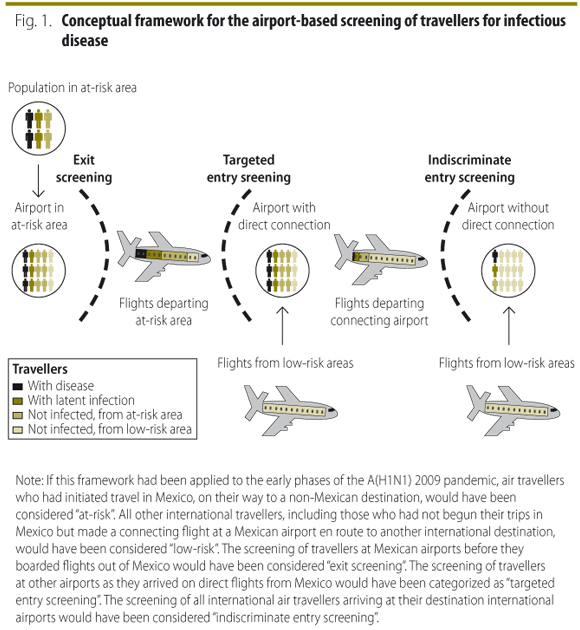
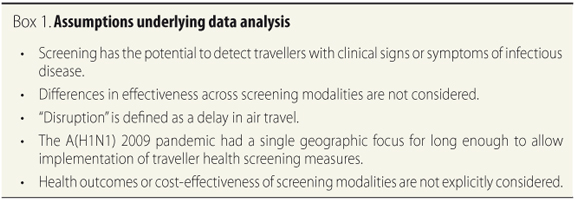
We first analysed data on worldwide flight itineraries collected by the International Air Transport Association.21 These data were used to quantify the monthly numbers of international travellers arriving in or departing from Mexico in 2007, 2008 and 2009. To determine the origins and final destinations of these air travellers accurately, we analysed full-route flight itineraries from a database of the International Air Transport Association that covered more than 6 billion individual passenger trips that occurred in 20072009 (or an estimated 95% of the world's commercial air traffic over this period).21 We then quantified the weekly numbers of A(H1N1) pandemic-related news stories that were recorded in 2009 by the Global Public Health Intelligence Network22 an epidemic-intelligence tool that monitors thousands of web sites in seven languages for news of emerging infectious disease threats. The trends in the weekly numbers of such stories were then compared with the deviations (from the "usual" traffic observed in the pre-pandemic years of 2007 and 2008) seen in international air traffic over Mexico in 2009.
Next, we analysed the flight itineraries of individual international travellers who departed from Mexico in April or May of 2009. The time period of this investigation was centred upon the first detection of signs of an A(H1N1) epidemic in Mexico in 2009 (in early April 2009) and the time when the international significance of the epidemic was first recognized (in late April 2009).23 Over this period, any person who initiated travel from any domestic or international airport in Mexico was categorized as being "at-risk" of carrying A(H1N1)pdm09. All other air travellers, including those who initiated travel outside Mexico but changed flights at a Mexican airport en route to a non-Mexican destination, were considered to be at low risk of carrying A(H1N1)pdm09.
We then compared the relative disruption in international air traffic that would have resulted from the screening of air travellers at the point of their departure from any international airport in Mexico (i.e. "exit" screening) with that which would have resulted from the screening of all passengers arriving at other international airports after flying from Mexico on a direct flight (i.e. targeted "entry" screening) or by any, direct or connecting flight (i.e. indiscriminate "entry" screening). For each scenario, disruption in air traffic was evaluated by considering (i) the numbers of cities and countries where health screening would have been needed to screen all at-risk travellers and (ii) the number of travellers who would have had to be screened for every traveller at risk.
The probability that travellers who had departed from Mexico while latently infected with A(H1N1)pdm09 (undetectable at exit screening) developed symptomatic disease during the course of travel (and so became potentially detectable by any subsequent entry screening) was estimated. For this, the median travel times (and interquartile ranges) for all at-risk travellers, from their initial flight in Mexico until their departure from one of Mexico's international airports or their arrival at either any international airport receiving flights directly from Mexico or the last international airport in their final destination country, were determined. These values represent the median times between the at-risk travellers beginning their international trips and the latest opportunity when they could have been assessed by exit screening, targeted entry screening and indiscriminate entry screening, respectively. Travel times were calculated using the relevant 2009 flight schedules. These schedules were investigated using aviation databases from OAG (Luton, United Kingdom of Great Britain and Northern Ireland),24 assuming that all flights arrived and departed on time.
Results
Mexico experienced a precipitous but short-term decline in international air travel once news of the A(H1N1) outbreak in the country reached the mainstream media, in late April 2009 (Appendix A, available at: http://www.biodiaspora.com/BWHO_Appendices.pdf ) . There was no evidence to indicate that news of an emerging pandemic threat triggered a sustained exodus of travellers out of Mexico, as the falls seen in the monthly numbers of international air travellers arriving in Mexico were matched by similar drops in the corresponding numbers of air travellers who left Mexico ( Table 1 ).
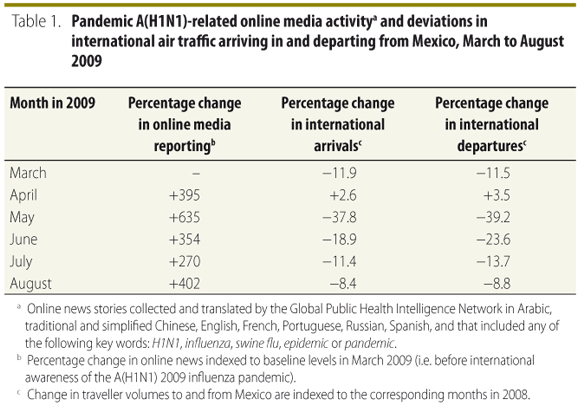
Analysis of the flight itineraries of the 583 774 at-risk travellers who flew out of Mexico in May 2009 revealed that exit screening would have caused the least disruption to international air traffic ( Table 2 ). Using this method of screening, all travellers at risk of transporting A(H1N1)pdm09 could have been assessed as they departed from one of Mexico's 36 international airports (which are in 35 different cities). Exit screening at just six airports in Mexico would have allowed for the assessment of about 90% of all travellers at risk (Appendix B, available at: http://www. biodiaspora.com/BWHO_Appendices. pdf ). Only 6017 (1%) of the international air travellers who left Mexico in May 2009 were categorized as being at low risk of infection with A(H1N1)pdm09. Targeted entry screening, although involving the same travellers as exit screening, would have been more complicated, since it would have required health screening at 82 international airports in 26 countries. Indiscriminate entry screening would have been highly impractical and inefficient, since 67.3 million "low-risk" travellers at 1111 international airports would have had to be assessed to ensure that every at-risk traveller from Mexico was screened. The results for the at-risk travellers who flew out of Mexico in April 2009 were generally similar (Appendix C, available at: http://www.biodiaspora.com/BWHO_Appendices.pdf ).
Entry screening has an advantage over exit screening in that it can detect travellers latently infected with a pathogen when they initiate travel but who go on to become symptomatic during the course of travel. However, this potential advantage will be small when the time spent in the air is only a small proportion of the incubation period of the pathogen. The median incubation period for A(H1N1)pdm09 in humans is about 2 days (range: 17),25 but 78% and 91% of the at-risk travellers who flew from Mexico in May 2009 should have ended their air travel within 6 and 12 hours, respectively. At this time, the median scheduled travel time for direct flights between Mexico and 80 of the 82 cities that received such flights was < 12 hours, and even the longest direct flights from Mexico those to Shanghai (20.17 hours) and Tokyo (17.25 hours) should have taken less than one day ( Fig. 2 ).
Discussion
The 194 national signatories to the 2005 International Health Regulations agreed collectively to mitigate the spread of infectious diseases in a manner that would avoid "unnecessary interference with international traffic and trade".9 To achieve this goal, national authorities worldwide need to be able to distinguish interventions with "reasonable" public health returns from those that should be considered unnecessary because they are minimally effective and excessively disruptive to traffic and trade.19 The results of our analyses of the patterns of global air traffic during a real pandemic indicate that the indiscriminate entry screening of travellers on international flights would be highly disruptive, inefficient and impractical. Compared with exit screening in areas at risk, indiscriminate entry screening could be marginally more effective but would be vastly more inefficient because the cohort to be screened would comprise at-risk travellers within a much larger pool of low-risk travellers from areas of the world with little or no epidemic activity. According to our criteria, just 0.11% and 0.07% of all air travellers who arrived, in April and May of 2009, respectively, at international airports on international flights that did not originate in Mexico would have been at risk of infection with A(H1N1)pdm09. The positive predictive value of the indiscriminate entry screening of international air travellers at this time would therefore have been extremely low, even if the screening method used had been highly sensitive and specific. For example, if 1% of the at-risk travellers who arrived in international airports on flights that did not originate in Mexico had had symptomatic A(H1N1)pdm09 infection and if the method used for entry screening for such infection had a specificity and a sensitivity of 99%, the positive predictive value of the screening would still have been < 0.1% (i.e. fewer than 10 in every 10 000 travellers found positive in the screening test would actually have been infected with A(H1N1)pdm09). From a local public health standpoint, indiscriminate entry screening would probably be counterproductive, since it would draw valuable health and human resources away from areas of potentially greater need. Thus, in the A(H1N1) 2009 pandemic, assessment of the health status of travellers at 99.3% of the world's international airports could have been foregone at the expense of very few missed opportunities to prevent or delay the spread of A(H1N1)pdm09.
For the initial stages of the A(H1N1) 2009 pandemic and, presumably, for other pandemics caused by pathogens that have similar or longer incubations periods than A(H1N1)pdm09 in humans the potential benefits of targeted entry screening over exit screening appeared marginal because most international flights are of short duration relative to the incubation period of most pathogens. In 2009, most international flights took less than 12 hours ( Fig. 3 ), with most such flights occurring within the same global region or between neighbouring regions (Appendix D, available at: http://www.biodiaspora.com/BWHO_Appendices.pdf ). If travellers are harbouring infectious agents with very short incubation periods and are travelling on long, intercontinental, non-stop flights from areas with substantial epidemic activity, then entry screening at their destination airports as a supplement to exit screening at the airports where the flights began may be a reasonable option. In general, such "supplementary" entry screening should be minimally disruptive to international travel because since traveller numbers tend to be inversely correlated with travel distance and flight duration ( Fig. 4 ) the numbers of travellers involved should be relatively small. However, the full, global public health benefits of targeted entry screening are only likely to be observed if all of the destination airports implement such screening in unison, which may be an unrealistic goal.


Although exit screening is more efficient than entry screening, significant political, legal and practical obstacles often hamper the timely and effective implementation of national strategies for exit screening. Currently, most national quarantine authorities are structured to prevent the import of pathogens but not their export. Similarly, the customs and passport control infrastructures at most international airports which could be used as the basis of a health screening programme are focused on arrivals rather than departures. Furthermore, at least in the short-term, the benefits of exit screening in any country with an epidemic would be realized entirely by other countries while placing additional strain on the source country.26 These realities should create incentives for countries that are currently unaffected by the pathogen producing the epidemic particularly those with strong travel ties to the affected country to offer international assistance as a means to protect their own vital interests. If epidemic source control and timely and effective exit screening are not attainable, then targeted entry screening could mitigate the impact of imported disease, as a supplement to a robust, community-level response.
Based on the results of the present, retrospective evaluation, we developed a decision-support tool for national authorities confronted with the formidable challenge of making rational, timely and defensible decisions about the health screening of travellers during future epidemics of international concern ( Fig. 5 ). Importantly, this tool takes account of the position of the city in which screening is being contemplated, in relation to the geographical source of the epidemic of concern as well as the continuously evolving, global network of air travel and transportation. Hence, it can offer recommendations that are customized to individual cities responding to epidemic threats that are emerging in different geographical regions and at different times. If this tool had been used during the initial stages of the A(H1N1) 2009 pandemic, we estimate that over 90% of the public health benefits attainable worldwide by screening international travellers could have been realized by intervening at just eight international airports (i.e. by exit screening at Mexico's six largest international airports and targeted entry screening at the international airports in Shanghai and Tokyo).
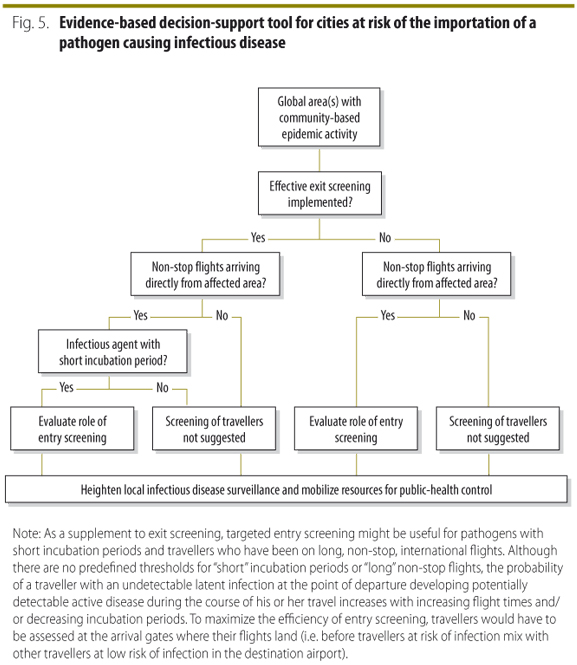
The present study has several limitations. We did not address the issues of whether international air travellers should be screened at all or, if it is determined that they should, of when the screening programmes should be initiated and discontinued. We believe that the answers to these questions cannot be easily generalized but, instead, must be adapted to the articulated goals of any screening, the levels of risk tolerance of national health authorities, and the specific circumstances that arise during future epidemics or pandemics of infectious disease. Factors that could influence the decision to screen travellers include (but are not limited to): (i) the estimated probability of successful source control and, failing that, the estimated probability of the international export of the pathogen; (ii) the estimated prevalences of infection and symptomatic disease in travellers11 ; (iii) the clinical spectrum of illness and the ability to detect relevant illness through direct observation, traveller health declarations, and/or complementary tests such as infrared thermography; (iv) the operating characteristics and limitations of the available screening methods27 ; (v) the global epidemiologic pattern of the epidemic disease at the time when traveller screening is first contemplated10 ; (vi) the opportunity costs of detecting other infectious diseases of lesser significance as a consequence of screening28 ; (vii) the perceived contagiousness and severity of the epidemic disease and its estimated domestic health and economic impacts29 ; (viii) the availability and costs of any effective methods for the prevention or treatment of the epidemic disease; and (ix) the projected public health benefits of health screening at airports (relative to those that could be realized by intervening at other international and/or domestic frontiers).
The conclusions of our analysis are drawn from the experience of a pandemic emerging in Mexico, which is not a leading transit hub for international travellers. If a future pandemic were to emerge around a major international transit hub (e.g. Frankfurt), a greater proportion of travellers departing from that hub would be low-risk travellers who had initiated trips from areas of the world with little or no infectious disease activity and were simply passing through the hub, en route to their final destinations. In such instances, the prevalence of detectable disease and, consequently, the positive predictive value of any screening method would decline unless international transit travellers could easily be separated from other international travellers within the hub.
For the present evaluation, we used static definitions of "at-risk" and "low-risk" travellers based on the presumption that the international spread of A(H1N1)pdm09 out of non-Mexican cities in April and May of 2009 was negligible. During this period, however, there was community-based transmission of the virus in many cities in Europe and North America, some of which became secondary sources for the pathogen's international spread.30 This serves as a reminder that the definitions of "at-risk" and "low-risk" travellers may need frequent revision and that the advantages of targeted entry screening, compared with those of indiscriminate entry screening, decrease as an epidemic becomes globalized. Although over the course of an international epidemic, health officials could regularly expand the list of at-risk areas and subject only travellers arriving from such areas to entry screening, this approach would increasingly disrupt the flow of international air traffic while providing diminishing public health benefits. Conversely, short-term exit screening whether directed solely at the epicentre of an epidemic or at any city with community-based epidemic activity that could lead to the international export of the pathogen would cause significantly less disruption to air traffic and would more closely align with the stated purpose and spirit of the 2005 International Health Regulations.9
For centuries, countries have been screening travellers arriving at their borders to protect their own health, security and economic interests.31 In an increasingly globalized world, where the interests of cities and countries are increasingly intertwined, entry screening although deeply rooted in a sense of self-preservation appears to be an anachronism. From a contemporary perspective, interventions to mitigate the international spread of infectious disease whether through preparedness or response would have the greatest global impact if implemented as close as possible to the sources of any future epidemic threats.32 
Acknowledgements
We are grateful to the Global Public Health Intelligence Network for sharing statistics on A(H1N1)-related online media activity during the course of the 2009 influenza pandemic.
The opinions expressed in this article are those of the authors and do not necessarily represent those of the Public Health Agency of Canada, the United States (US) Centers for Disease Control and Prevention, the US Department of Health and Human Services or the US Government.
Funding: Funding was provided by the Canadian Institutes of Health Research.
Competing interests: KK owns intellectual-property rights in BioDiaspora, a technology dedicated to understanding the role of global travel in the international spread of infectious diseases.
References
1. The World Health Report 2007 a safer future: global public health security in the 21st century. Geneva: World Health Organization; 2007. Available from: http://www.who.int/whr/2007/en/index.html [accessed 1 January 2012] .
2. Jones KE, Patel NG, Levy MA, Storeygard A, Balk D, Gittleman JL et al. Global trends in emerging infectious diseases. Nature 2008;451:9903. doi: http://dx.doi.org/10.1038/nature06536 PMID: 18288193
3. Alirol E, Getaz L, Stoll B, Chappuis F, Loutan L. Urbanisation and infectious diseases in a globalised world. Lancet Infect Dis 2011;11:13141. doi: http://dx.doi.org/10.1016/S1473-3099(10)70223-1 PMID: 21272793
4. Altizer S, Bartel R, Han BA. Animal migration and infectious disease risk. Science 2011;331:296302. doi: http://dx.doi.org/10.1126/science.1194694 PMID: 21252339
5. Semenza JC, Menne B. Climate change and infectious diseases in Europe. Lancet Infect Dis 2009;9:36575. doi: http://dx.doi.org/10.1016/S1473-3099(09)70104-5 PMID: 19467476
6. Colizza V, Barrat A, Barthélemy M, Vespignani A. The role of the airline transportation network in the prediction and predictability of global epidemics. Proc Natl Acad Sci USA 2006;103:201520. doi: http://dx.doi.org/10.1073/pnas.0510525103 PMID: 16461461
7. Centers for Disease Control and Prevention. Risk for meningococcal disease associated with the Hajj 2001. MMWR Morb Mortal Wkly Rep 2001;50:978. PMID: 11263795
8. Lee N, Hui D, Wu A, Chan P, Cameron P, Joynt GM et al. A major outbreak of severe acute respiratory syndrome in Hong Kong. N Engl J Med 2003;348:198694. doi: http://dx.doi.org/10.1056/NEJMoa030685 PMID: 12682352
9. Revision of the International Health Regulations (2005). Geneva: World Health Organization; 2008. Available from: http://www.who.int/csr/ihr/en/ [accessed 1 January 2012] .
10. Khan K, Arino J, Hu W, Raposo P, Sears J, Calderon F et al. Spread of a novel influenza A (H1N1) virus via global airline transportation. N Engl J Med 2009;361:2124. doi: http://dx.doi.org/10.1056/NEJMc0904559 PMID: 19564630
11. St John RK, King A, de Jong D, Bodie-Collins M, Squires SG, Tam TW. Border screening for SARS. Emerg Infect Dis 2005;11:610. PMID: 15705315
12. Pitman RJ, Cooper BS, Trotter CL, Gay NJ, Edmunds WJ. Entry screening for severe acute respiratory syndrome (SARS) or influenza: policy evaluation. BMJ 2005;331:12423. doi: http://dx.doi.org/10.1136/bmj.38573.696100.3A PMID: 16176938
13. Hollingsworth TD, Ferguson NM, Anderson RM. Will travel restrictions control the international spread of pandemic influenza? Nat Med 2006;12:4979. doi: http://dx.doi.org/10.1038/nm0506-497 PMID: 16675989
14. Epstein JM, Goedecke DM, Yu F, Morris RJ, Wagener DK, Bobashev GV. Controlling pandemic flu: the value of international air travel restrictions. PLoS ONE 2007;2:e401. doi: http://dx.doi.org/10.1371/journal.pone.0000401 PMID: 17476323
15. Duncan AR, Priest PC, Jennings LC, Brunton CR, Baker MG. Screening for influenza infection in international airline travelers. Am J Public Health 2009;99(Suppl 2):S3602. doi: http://dx.doi.org/10.2105/AJPH.2008.158071 PMID: 19797749
16. Evans AD, Thibeault C. Prevention of spread of communicable disease by air travel. Aviat Space Environ Med 2009;80:6012. doi: http://dx.doi.org/10.3357/ASEM.2560.2009 PMID: 19601500
17. Gaber W, Goetsch U, Diel R, Doerr HW, Gottschalk R. Screening for infectious diseases at international airports: the Frankfurt model. Aviat Space Environ Med 2009;80:595600. doi: http://dx.doi.org/10.3357/ASEM.2360.2009 PMID: 19601499
18. Nishiura H, Wilson N, Baker MG. Quarantine for pandemic influenza control at the borders of small island nations. BMC Infect Dis 2009;9:27. PMID: 19284571
19. Implementation of the International Health Regulations (2005). Report of the review committee on the function of the International Health Regulations (2005) in relation to pandemic (H1N1) 2009. Geneva: World Health Organization; 2011. Available from: http://apps.who.int/gb/ebwha/pdf_files/WHA64/A64_10-en.pdf [accessed 1 January 2012] .
20. Cowling BJ, Lau LL, Wu P, Wong HW, Fang VJ, Riley S et al. Entry screening to delay local transmission of 2009 pandemic influenza A (H1N1). BMC Infect Dis 2010;10:82. doi: http://dx.doi.org/10.1186/1471-2334-10-82 PMID: 20353566
21. International Air Transport Association [Internet]. Montreal: IATA; 2013. Available from: http://www.iata.org [accessed 21 March 2013] .
22. Mykhalovskiy E, Weir L. The Global Public Health Intelligence Network and early warning outbreak detection: a Canadian contribution to global public health. Can J Public Health 2006;97:424. PMID: 16512327
23. Brownstein JS, Freifeld CC, Chan EH, Keller M, Sonricker AL, Mekaru SR et al. Information technology and global surveillance of cases of 2009 H1N1 influenza. N Engl J Med 2010;362:17315. doi: http://dx.doi.org/10.1056/NEJMsr1002707 PMID: 20445186
24. Official Airline Guide [Internet]. Data. Luton: OAG; 2013. Available from: http://www.oag.com/Aviation-Data [accessed 21 March 2013] .
25. Cao B, Li XW, Mao Y, Wang J, Lu HZ, Chen YS et al. Clinical features of the initial cases of 2009 pandemic influenza A (H1N1) virus infection in China. N Engl J Med 2009;361:250717. doi: http://dx.doi.org/10.1056/NEJMoa0906612 PMID: 20007555
26. Aguilar-Zinser V, Chaparro-González Y. Tracking Influenza H1N1 in travelers in Mexico. Mexico City: Secretariat of Communications and Transport; 2009.
27. Bitar D, Goubar A, Desenclos JC. International travels and fever screening during epidemics: a literature review on the effectiveness and potential use of non-contact infrared thermometers. Euro Surveill 2009;14:19115. PMID: 19215720
28. Shu P-Y, Chien L-J, Chang S-F, Su C-L, Kuo Y-C, Liao T-L et al. Fever screening at airports and imported dengue. Emerg Infect Dis 2005;11:4602. doi: http://dx.doi.org/10.3201/eid1103.040420 PMID: 15757566
29. Ferguson NM, Cummings DA, Cauchemez S, Fraser C, Riley S, Meeyai A et al. Strategies for containing an emerging influenza pandemic in Southeast Asia. Nature 2005;437:20914. doi: http://dx.doi.org/10.1038/nature04017 PMID: 16079797
30. Mukherjee P, Lim PL, Chow A, Barkham T, Seow E, Win MK et al. Epidemiology of travel-associated pandemic (H1N1) 2009 infection in 116 patients, Singapore. Emerg Infect Dis 2010;16:216. doi: http://dx.doi.org/10.3201/eid1512.091376 PMID: 20031038
31. Gensini GF, Yacoub MH, Conti AA. The concept of quarantine in history: from plague to SARS. J Infect 2004;49:25761. doi: http://dx.doi.org/10.1016/j.jinf.2004.03.002 PMID: 15474622
32. Cooper BS, Pitman RJ, Edmunds WJ, Gay NJ. Delaying the international spread of pandemic influenza. PLoS Med 2006;3:e212. doi: http://dx.doi.org/10.1371/journal.pmed.0030212 PMID: 16640458
(Submitted: 12 December 2012 Revised version received: 1 February 2013 Accepted: 6 February 2013 Published online: 27 March 2013)
* Correspondence to Kamran Khan (e-mail: khank@smh.ca).
